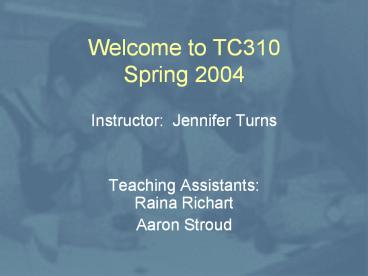Welcome to TC310 Spring 2004 - PowerPoint PPT Presentation
1 / 14
Title:
Welcome to TC310 Spring 2004
Description:
What software tools are important for TC professionals? ... Atman, Cynthia J., Justin R. Chimka, Karen M. Bursic, and H. L. Nachtmann, 'A ... – PowerPoint PPT presentation
Number of Views:12
Avg rating:3.0/5.0
Title: Welcome to TC310 Spring 2004
1
Welcome to TC310Spring 2004
- Instructor Jennifer Turns
- Teaching AssistantsRaina Richart
- Aaron Stroud
2
Todays Plan
- Go over syllabus
- Exercises to introduce class themes
- Moving to assignment 1, Analysis
3
TC 310 - Syllabus
- Key Points
- Learning objectives
- Assignments and Grading
- Class schedule and structure
- Read on your own
- Required materials
- Student responsibilities
- Instructor responsibilities
4
Questions
- What software tools are important for TC
professionals? - What does it mean to know how to use software
like a TC professional? - What strategies do you prefer to use when
learning new software?
5
Questions
- What is technical communication?
- What is design?
- What is usability?
6
Design Process ActivitiesDerived from analysis
of 7 engineering texts
- Identification of a Need
- Problem Definition
- Information Gathering
- Generation of Ideas
- Modeling
- Feasibility of analysis
- Evaluation
- Decision
- Communication
- Implementation
Problem Scoping Exploring Alternative
Solutions Project Realization
7
Design Process Timelines
Successful Graduating Student (Quality Score
0.63)
Canonical Entering Student (Quality Score 0.37)
Atman, Cynthia J., Justin R. Chimka, Karen M.
Bursic, and H. L. Nachtmann, A Comparison of
Freshman and Senior Engineering Design
Processes, Design Studies, vol. 20, no. 2, pp.
131-152, March 1999.
8
Design Process Timelines
Atman, Cynthia J., Justin R. Chimka, Karen M.
Bursic, and H. L. Nachtmann, A Comparison of
Freshman and Senior Engineering Design
Processes, Design Studies, vol. 20, no. 2, pp.
131-152, March 1999.
9
Dimensions of Usability
- Definition
- The extent to which a product ca be used by
specified users to achieve specified goals in a
specified context of use with effectiveness,
efficiency and satisfaction. ISO-9241-11 - From Nielsen
- Satisfaction, Learnability, Memorability, Errors,
Efficiency - Also
- Understandability, Scannability, Readability
10
Homework (for Wednesday)
- A continuation of these activities
- Two parts
- Complete getting to know you surveyAvailable
through the course website - Submit your first assignment in E-portfolioA 300
word explanation of TC - Due Wednesday at 800 am (so we can go over
responses by class time).
11
Moving on to Assignment 1
- Read assignment 1
- Analysis of the communication event
- What does this mean?
- What did you learn in TC 231, TC333 and other TC
classes?
12
Analysis of the communication event
- Some questions
- Product What exactly are you being asked to
design? - Users Who are the users? What do we know
(would we like to know) about the users? - Tasks What tasks will the users do with the
product? - Context What is the context in which these
tasks will be carried out? Under what
circumstances? - Usability What usability considerations are
relevant here? - Your task Think pair share
13
Product Statement Useful synthesis
- Example
- The product will be a responsive, understandable,
flexible Internet site that offers basic customer
services, keeps customers well informed, and
partners with the community to protect the
environment. The web site will primarily support
SPU residential service customers to manage their
accounts, access service information, and access
environmental information in a way that is easy,
fast, efficient, and instills trust. In
addition, the site will support tiered access for
the following audiences SPU commercial
customers, engineers and contractors, community
organizations, and the media.
14
Product Statement
Product Type
Product Characteristics
- Example
- The product will be a responsive, understandable,
flexible Internet site that offers basic customer
services, keeps customers well informed, and
partners with the community to protect the
environment. The web site will primarily support
SPU residential service customers to manage their
accounts, access service information, and access
environmental information in a way that is easy,
fast, efficient, and instills trust. In
addition, the site will support tiered access for
the following audiences SPU commercial
customers, engineers and contractors, community
organizations, and the media.
Business Goals
Tasks supported
Usability criteria
Users































